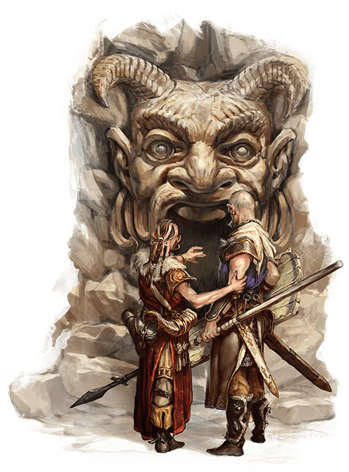 Games have challenges. Stories, at least the kinds that most of us think of when we think of stories, have the protagonists fighting to overcome something—even if it’s just their own internal challenges. A significant portion of this series of articles has focused on the encounter as the container that holds and presents the challenges that the character must deal with. So let’s take a moment to think about those challenges, and how they fit both into the encounters that form the adventure, as well as the stories that evolve from the adventures.
Games have challenges. Stories, at least the kinds that most of us think of when we think of stories, have the protagonists fighting to overcome something—even if it’s just their own internal challenges. A significant portion of this series of articles has focused on the encounter as the container that holds and presents the challenges that the character must deal with. So let’s take a moment to think about those challenges, and how they fit both into the encounters that form the adventure, as well as the stories that evolve from the adventures.
Challenges in a D&D adventure come in many varieties. The most obvious is the fearsome monster, bringing danger to civilized folks and keeping the heroes away from wonderful treasure. Diabolical traps and deadly hazards offer challenges as well. Arcane puzzles must be overcome on adventures. And most importantly of all, the characters face tough choices every day of their adventuring life. These are the tools we, as adventure creators, have to challenge the characters with.
A Note on Story
If you’ve read my entire series of articles so far, looked at any of my other writing, or listened to me talk about D&D at a convention, you’ll probably get sick of hearing me say this, but here goes: D&D is challenging to create for because it’s both a game and a story-delivery vehicle. Those two aspects can be looked at discretely, or they can be looked at in terms of how they interact with each other. Even as I’ve written about encounters in this series, that nagging voice in my mind keeps saying, “Don’t forget to talk about story! Think about the story too!”
Intermingling with all the talk of pillars and challenges and encounters needs to be the threads of the story that our adventure is facilitating. Notice I didn’t say “telling.” As adventure writers, we are not telling a story. We’re giving the DMs and players a blueprint from which they can build their own story. That’s one of the reasons why, when I think about adventure, I put the concept of “story” in the background a bit in my mind. Our adventure shouldn’t be a story: it should instead be a story-processing machine that input the players’ decisions, the rolls of the dice, and the guidance of the DMs. As the process plays out, the participants in the game interact with your adventure-machine to output a story that they all built together.
We can’t, however, ignore story completely as we build our adventures. Story elements need to be the paint with which we coat our adventure-machine. More importantly, those elements also need to hold the gears of the machine together. We can’t write what happens, but we can write toward the events that are likely to happen, and count on the imagination and judgement of the DM to duct-tape everything together if what we create breaks down.
I mention story particularly here because as we talk about the different types of challenges we might put into our encounters and our adventures, we can think of how these challenges are going to affect the encounters, but how they might be pieced into the story that the games’ participants are going to collectively tell.
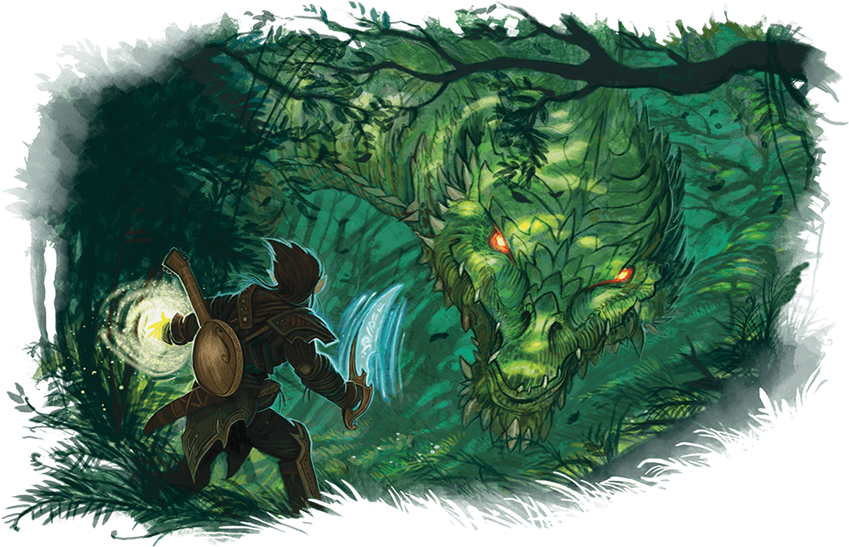
Monsters
How important are monsters in D&D? Well, they have their very own book! And more than one book at that! They’re often the most significant challenge in a D&D encounter, and in the game as a whole. When talk about “monsters” in this article, we’re using the word as shorthand. Here, “monster” is a shorthand moniker for any creature that we as adventure creators are fairly certain will spark a combat encounter when put in close proximity with adventurers. Intelligent foes typically aren’t considered monsters, even in RPG design shorthand, since there are good odds that the characters can choose to roleplay their way out of a combat scenario with intelligent humanoids, dragons, and so on.
In terms of challenges, resolutions, and consequences, monsters are generally very easy to use and conceptualize: they are a pass/fail condition. If the characters defeat the monsters, they can continue their story. If they fail to defeat the monsters, then the monsters probably won the battle, which means the story of the characters has come to a grisly end.
It’s never that simple, of course. The monsters winning can instead mean the characters are taking prisoner, meaning their story continues in a different manner. Monsters might be communicative and open to negotiation, which leads to a different resolution and consequence to the challenge presented.
Choosing Monsters
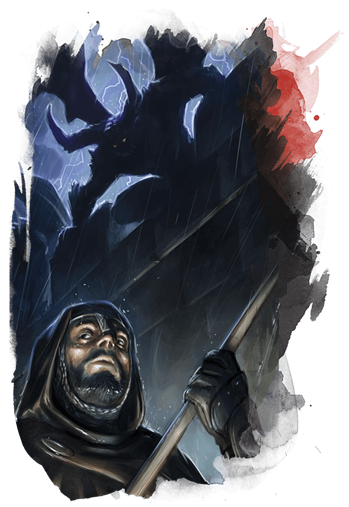 When putting monsters into an adventure, think about what their roles are—both in the game mechanics of the adventure and in the story you’re facilitating. Are the monsters there in their most basic “kill or be killed” role? What is their function as a story element? What are the consequences of resolutions other than a fight to the death?
When putting monsters into an adventure, think about what their roles are—both in the game mechanics of the adventure and in the story you’re facilitating. Are the monsters there in their most basic “kill or be killed” role? What is their function as a story element? What are the consequences of resolutions other than a fight to the death?
The Dungeon Master’s Guide provides a useful system for determining if the challenges provided by the monsters are suitable for the characters. And since you, as an adventure designer for the general public, have no idea what the capabilities of the characters playing this adventure are, it’s a good idea to use the help your given. (D&D Beyond has an Encounter Builder that can help you determine encounter difficulty as well. I use it all the time!)
Fortunately, we have a wide array of monsters available to us at different levels of difficulty (known as challenge ratings or simply CR), so we have options. Need a monster who is more intelligent and capable performing the tasks asked of it in your adventure? You can differentiate that monster from one that works on bestial instincts. This is important, because the resolutions and consequences of those challenges, even if they are the same challenge rating, could be very, very different.
Creating/Reskinning Monsters
A time will come in your adventure design when the perfect monster at a particular CR will not exist. But fear not! You are creative, you are talented, and you’ve got tools at your disposal. Creating your own monster from scratch is an option. That, however, is a topic beyond our scope today. Instead, let’s talk about reskinning monsters.
Reskinning simply means taking an existing monster and describing it in a different way. Here’s an example from a project I was working on early today!
I needed a monster that was CR 6. This creature is a powerful wolf-creature, essentially the perfect form of a wolf that might dwell in a plane of perfection. A dire wolf might be something to consider, but it is only CR 1. Adjusting that monster up to CR 6 is more work that I want to do. So instead I did a quick search (on D&D Beyond, of course) of all CR 6 monsters.
My eye was drawn to the wyvern. Although it’s a dragon, rather than a beast, it still has a barely higher-than-bestial intellect (that is, an Intelligence score of 5). It’s AC and hit points look good. I remove the fly speed, and make its walking speed 40 like a wolf. The wyvern has a stinger, which our super-wolf doesn’t have. But if I make the stinger attack into its bite attack, and change the poison to an acidic saliva of this ultra-predator, I have a close-enough monster that fits what I need. Then just describe the wyvern as a large and brutal wolf, and I have a monster that I know fits the correct challenge without too much work. This isn’t perfect, but it’s a quick-and-dirty solution that will serve you well unless your monster needs to be specifically tailor-made.
Monsters and Resolutions and Consequences
It bears saying this, because it’s a mistake I see made by adventure designers, myself included: think about the goals, desires, knowledge, and personalities of monsters when you put them into your adventures, especially if they are even semi-intelligent. So often my players have captured rather than killed their enemies in order to question them or show them mercy, and I’ve been at a loss. What do these enemies know? What can they offer for their lives? What will their reaction be if they are freed? Answering these questions helps DMs running your adventure to deal with the consequences, and in turn possibly tell a much more powerful story.
Traps/Hazards
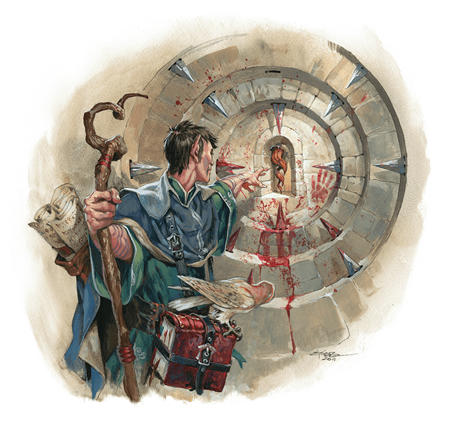 Traps have played an important part of D&D since its earliest days. One needs only look at an adventure like Tomb of Horrors (which you can find in Tales from the Yawning Portal) to see that traps are meant to be significant challenges with pretty severe consequences. Rogue and thief, as classes over the editions of the game, have special abilities tied directly to finding and removing traps. Xanathar’s Guide to Everything dedicated an entire chapter to revisiting the rules on traps, to go along with the traps presented in the Dungeon Master’s Guide.
Traps have played an important part of D&D since its earliest days. One needs only look at an adventure like Tomb of Horrors (which you can find in Tales from the Yawning Portal) to see that traps are meant to be significant challenges with pretty severe consequences. Rogue and thief, as classes over the editions of the game, have special abilities tied directly to finding and removing traps. Xanathar’s Guide to Everything dedicated an entire chapter to revisiting the rules on traps, to go along with the traps presented in the Dungeon Master’s Guide.
Though traps and hazards are inanimate, unthinking objects, the same questions we asked about monsters apply perfectly well here, too. What is its purpose? What is the state of its existence outside of their relationship to the characters? What resolution can be enacted apart from either being avoided or draining character resources? What alternative consequences can be attached to them?
Obviously, traps that simply do damage before becoming inconsequential are fine. Nothing says adventure like a good pit trap. However, thinking about traps in terms of their role in the story is important as well. Hordes of goblins infesting a cave system might not have the means to create complicated traps, so a trap that rings an alarm is more feasible for them. That lets them bring down intruders with a coordinated counterattack based on sheer numbers. Kobolds, with their ingenuity, might prefer traps that damage and incapacitate, for they want to stay as far from harm as possible. A wizard has more access to devastating magical traps, but traps that warn might be just as effective, for that gives the wizard time to use her magic to prepare for a confrontation on her own terms.
As with monsters, diversity of presentation and focus on resolution and consequences is more important than simply overwhelming encounters with one difficult scene after another. Intersperse simple traps with complex ones. Alternate deadly ones with those that do no damage but have other consequences. Provide different degrees of success or failure for traps that are dealt with in different ways.
Puzzles
Puzzles are another topic worthy of a completely separate article, or even series of columns. Like traps, puzzles have a storied history in D&D. Many players love them. Other players despise them. The silent majority of player appreciate them if done well, but tolerate them through clenched teeth if done poorly. Here are some quick thoughts on adding puzzle challenges to your adventures.
- Do not make puzzles a pass/fail element of your adventure. Instead, give various consequences for various states of success or failure. This allows the characters to continue the adventure even if the puzzle does not go smoothly for them.
- Puzzles that are too easy are much better than puzzles that are too hard. As a creator, you’d rather have players feel like geniuses than feel like the puzzle was unsolvable.
- It’s fine to challenge the players rather than the characters with puzzles, but also give options for the characters’ knowledge and intelligence to provide hints. Simply put, if the player is stuck in a puzzle, allow the character to know certain things that help solve it—or learn or recall those things with a level-appropriate Intelligence check.
- Work as hard as you can to have the puzzle make sense within the scope of the story. A banker is unlikely to have a complicated puzzle lock on the vault she needs to access 50 times a day. A tortured spirit from the realm of nightmares is much more likely to speak in riddles. Pick your puzzle battles carefully.
Continuing the Adventure
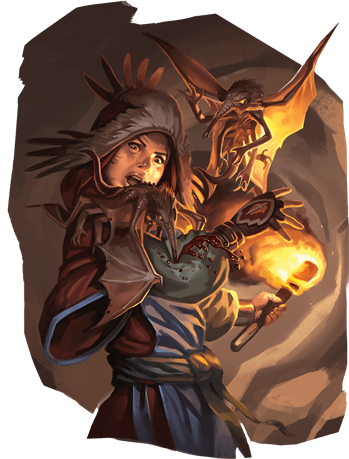 Let’s continue our adventure. Previously, the characters came upon a base of operations for a group dedicated to exploring an area on the edge of the known world, bringing back artifacts of lost civilizations for study. They were asked to check in to see how the base was doing, and they quickly learn something is terribly wrong there. They rescued a guide named Jodice who works for the exploration guild, and Jocide provided some information about what he knows.
Let’s continue our adventure. Previously, the characters came upon a base of operations for a group dedicated to exploring an area on the edge of the known world, bringing back artifacts of lost civilizations for study. They were asked to check in to see how the base was doing, and they quickly learn something is terribly wrong there. They rescued a guide named Jodice who works for the exploration guild, and Jocide provided some information about what he knows.
He’s told them how to get into the base: descend the tunnel, which is now fog-filled, and follow the passage forward until arriving at the door into the base itself. The characters must take it from here.
The tunnel slopes down, but the fog makes it very difficult to see more than 20 feet away, even when light is provided. The downward slope of the tunnel evens out after 150 feet of travel, but the continuing passage is still filled with fog. Perched on the right wall, barely visible 20 feet ahead after the tunnel evens out, are hundreds of tiny spiders carved from different stones and gems. They do not move.
This passageway is filled with an unholy vermin trap (see below). The first set of vermin are spiders, and the rune one the floor, drawn in fresh blood, is dedicated to Aranok, an ancient spider deity. Every 20 feet down the passage is another group of carved vermin, along with an accompany rune of another vermin deity: scorpions (Gholok), centipedes (Tinok), and mosquitos (Zellok). The swarms of animated vermin cannot be destroyed with weapons or spells—only the runes powering them can be deactivated, as described below.
Unholy Vermin Trap
Complex trap (Levels 5-10, deadly threat)
This passage is a death trap of magically animated vermin carvings.
Trigger. When a character enters the passage and moves adjacent to the first vermin rune, the entire trap is triggered.
Effect. If the trap is sprung, the four sets of vermin carvings animate and attack.
Vermin. On initiative count 20, the four different sets of vermin fly off the wall and attack. Each creature in the passage once must succeed on a DC 15 Constitution saving throw or take 5 (1d10) slashing damage per each set of vermin active, or half on a success.
Countermeasures. The runes that power the trap are visible on the floor, but characters must be within 20 feet of a rune to see it in the fog. The runes can be deactivated in a variety of ways, all requiring an action.
- A successful DC 15 Intelligence (Arcana) check allows a character within 20 feet of a rune to use knowledge of the arcane to deactivate a rune’s power.
- A successful DC 15 Dexterity (Sleight of Hand) allows a character adjacent to a rune to subtly deface it, distorting its magic.
- A successful DC 20 Strength (Athletics) check by a character adjacent to a rune lets them smash the rune enough to deactivate it.
- A successful DC 15 Intelligence (History or Religion) check by a character who can see the rune reveals the rune is dedicated to an ancient power associated with the different types of vermin represented; standing on the rune and speak the name of that vermin power figure suppresses the magic for 24 hours.
When a rune is deactivated, that group of vermin stop attacking When all four runes are deactivated, the trap ends. A dispel magic against a 5th-level spell can also disable a rune. The vermin statues do not leave the passage into the outdoors.
What’s Next?
In the next column, we reach our 10th installment of this “Let’s Design an Adventure” series, where we look at what it means to design like a designer. In this article we’ll look at concepts like writing habits, playtesting, proofreading, making maps, finding art, publishing, and other design tricks of the trade.
 Shawn Merwin's professional design, development, and editing work in D&D has spanned 20 years and over 4 million words of content, ranging from third to fifth edition. His most recent credits include the Acquisitions Incorporated book, Baldur’s Gate: Descent into Avernus, and Storm Lord’s Wrath. He is also the Resource Manager for the D&D Adventurers League’s Eberron: Oracle of War campaign. Shawn hosts a weekly D&D podcast called Down with D&D, and he holds an MFA in Creative Writing from Vermont College of Fine Arts. You can follow his ramblings and musing on Twitter at @shawnmerwin.
Shawn Merwin's professional design, development, and editing work in D&D has spanned 20 years and over 4 million words of content, ranging from third to fifth edition. His most recent credits include the Acquisitions Incorporated book, Baldur’s Gate: Descent into Avernus, and Storm Lord’s Wrath. He is also the Resource Manager for the D&D Adventurers League’s Eberron: Oracle of War campaign. Shawn hosts a weekly D&D podcast called Down with D&D, and he holds an MFA in Creative Writing from Vermont College of Fine Arts. You can follow his ramblings and musing on Twitter at @shawnmerwin.
Want to read more of this series? Click on the "Let's Design an Adventure!" tag to see the full series.

-
View User Profile
-
Send Message
Posted Mar 11, 2020Thanks Shawn! I love this trap and the set up so far, sounds like an excellent adventure/one shot material and I'm looking forward to using some of the techniques you've talk about here. Thanks so much!
-
View User Profile
-
Send Message
Posted Mar 11, 2020Thanks for sharing! Can you recommend a good resource for traps? I run pre-made adventures, but like to doctor them up with add-on things, like traps and puzzles. Any suggestions?
-
View User Profile
-
Send Message
Posted Mar 11, 2020If I were to encounter this trap, I'd be walking away from it with bags of gemstone statues of vermin. Gemstones are gemstones after all. Love it, though. It's a fun one.
-
View User Profile
-
Send Message
Posted Mar 11, 2020Thanks Shawn. I am enjoying this series. I have a few thoughts, though, for consideration.
"D&D is challenging to create for because it's both a game and a story-delivery vehicle." - this is genius but it's also a function of scale. What one needs to write for a 1 shot is quite different from writing an adventure module, or campaign. This is also a great time to encourage DM's to take the pulse of their group, find out how much they are into story and roleplay vs. dungeon crawling, because that factors into the balance of what needs to be written.
Grammar error "The monsters winning can instead mean the characters are taking prisoner..." should either be "characters are taken prisoner" or "the monsters are taking them as prisoners"
"(Creating/Reskinning Monsters, creating your own monsters from scratch) That, however, is a topic beyond our scope today." Here's a great chance to also say "But if you want more information on creating your own monsters from scratch, see DMG chapter 9 Dungeon Master's Workshop, and then provide a link [https://www.dndbeyond.com/sources/dmg/dungeon-masters-workshop#CreatingaMonster]
"Adjusting that monster up to CR 6 is more work that I want to do" - two things here. another grammar problem. This should be 'more work than I wanted to do' or similar. If you're trying to be sarcastic, its not clear. Second, I disagree. It's not hard at all to use the Monster Statistics by Challenge Rating table in DMG chapter 9. There you have a quick easy table to reset CR, proficiency, AC, HP, bonus, etc for a monster quite rapidly.
"Answering these questions helps DMs running your adventure to deal with the consequences, and in turn possibly tell a much more powerful story." preach it, brother, amen!
"A wizard has more access to devastating magical traps, but traps that warn might be just as effective, for that gives the wizard time to use (their) magic to prepare for a confrontation on (their) own terms." Tie-in point with "thinking" monsters. Hammer this point home. This is another reason why a DM needs at least some loose idea of why a monster is there, or why a wizard uses a flesh to stone trap instead of a disintegrate... or even a teleport, thus bamphing the target(s) out of their tower. aka dungeon ecology (things exist for a reason)
Interspersing simple/complex & alternating deadly/non-damaging traps is a good suggestion, but a better one would have been to get the DM to ask "why is this particular trap, of this type, here?" - I think you drifted back into module writing and stepped away from story on this point.
"It's fine to challenge the players rather than the characters with puzzles..." that's not your place to say and you're stepping on player agency here. If the group prefers staying in character and thus not figuring out a puzzle even if a particular player does, is up to them.
Regarding puzzles I would also have added that you might start the adventure out with a pretty simple puzzle, to get the PC's warmed up and thought-juices flowing so they become more excited about solving the next one.
All in all, another solid article.
-
View User Profile
-
Send Message
Posted Mar 11, 2020👍 Good article - funny though I feel like some of the WOTC books don’t provide some of the vitals noted in the article 🙄!
-
View User Profile
-
Send Message
Posted Mar 11, 2020Great article! Spotted a few typos, though:
Should be "taken". And:
Missing the word "of" after "capable". Also:
Judging from previous articles, "Jodice" is the correct spelling.
Anyway, a really interesting read! You make good points about the polarizing nature of puzzles.
-
View User Profile
-
Send Message
Posted Mar 12, 2020Nice great article.
-
View User Profile
-
Send Message
Posted Mar 14, 2020Unholy vermin trap: Very nicely done. That would be a blast to see the players negotiate. Any one of them could be the hero, making the check to figure out a way to end the threat, but having enough obstacles (the fog, the numerous deities to be recalled, the vermin’s immunity to attack) that the trap remains a viable threat.
-
View User Profile
-
Send Message
Posted Mar 15, 2020Thank you for this wonderful article. Speaking personally, I have been saddened hat Wizards has been so focused on expanding the brand that it risks losing its “game equilibrium” and becoming to diversified to quickly, causing unintended marginalization of gamers like me how are in my 50’s (I started with first addition :) It seems like Wizards wants to passively merge the Magic and D&D products. Makes good corporate sense but done too fast and without care for older gamers make me feel progressively marginalized in the community, and there could be a risk the Brand become liquified to the point it loses the spirit that made Dungeons & Dragons unique and legendary in the RPG world. There needs to be a balance of representation at Wizards for the love of D&D (as the current custodian of the Brand, and corporate/share-holder interests. Thank for listening to a grumbly old vet. Please be safe and you have our prayers today for everyone there at this stressful time. Remember to wash your hands during this challenging time in the world:). Peace & safety, Cuthbert2